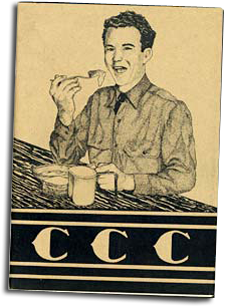 The Civilian Conservation Corps (CCC) gave jobs to thousands of young Oregonians and left a legacy of public works improvements. (OSA, Parks and Recreation Department Records, Boardman Collection, Box 2)
The Civilian Conservation Corps (CCC) gave jobs to thousands of young Oregonians and left a legacy of public works improvements. (OSA, Parks and Recreation Department Records, Boardman Collection, Box 2)
The Downward Spiral
The chain of events that followed the crash of the stock market in 1929 seemed unending and unstoppable. Those who owned stock certificates now found themselves holding worthless pieces of paper. Prestigious banks nationwide went bankrupt leaving their depositors' savings wiped out. Failing banks also led to foreclosures on businesses, homes, and farms, further eroding both the national and local economies. As money dried up, so did factory orders. Fewer factory orders meant more layoffs. More layoffs meant less money to spend in local merchandise shops and cafes as the downward spiral continued.
Despondent Americans looked for help to stop the spiral. But President Herbert Hoover, who grew up in Newberg, held the belief that government was not the solution. While he took some measures to attempt to stem the bleeding, he shared a strong philosophy with his Republican Party stalwarts that prevented a large scale government response.
The New Deal
Franklin Delano Roosevelt, the Democratic Party rival for the 1932 presidential election, was not so encumbered. And desperate Americans voted him in under the hope that at least some action would be better than none. Seizing the mandate, Roosevelt unleashed a whirlwind of federal government action dubbed the "New Deal." Many of his initiatives were aimed at restoring the battered confidence of Americans. Soon after taking office, he declared a "bank holiday" in which he closed financial institutions across the country until federal auditors could examine their books and decide on their solvency. Thousands of banks were closed down, but those that reopened could be trusted, assured Roosevelt.
Civilian Conservation Corps
The president then began cooking a pot of "alphabet soup" programs for economic recovery. Roosevelt recognized that he needed to get the millions of unemployed Americans back to work, as much for psychological reasons as for economic ones. While he met substantial political and legal resistance to his plans for unprecedented expansion of the federal government, most Americans supported him. The creation of the Civilian Conservation Corps (CCC) yielded far reaching consequences for Oregon. Not only did it provide employment for thousands of young Oregonians without jobs, but it left a myriad of functional and attractive improvements to the state's infrastructure. Bridges, roads, campgrounds, buildings, ranger stations, guard stations, fire lookouts, reservoirs, and other projects numbered among the achievements of the CCC in every part of Oregon.
Works Projects Administration
Meanwhile, the Works Projects Administration (WPA) employed many more Oregonians who worked as writers, teachers, lawyers, historians, painters, architects, masons, and in other arts, professions, and trades. Their work resulted in numerous books such as the fascinating tour of Oregon entitled "Oregon: End of the Trail." They also left monuments to the artists and craftsmen of the day with works such as the magnificent Timberline Lodge on the flanks of Mount Hood. The WPA, along with other federal agencies such as the Public Works Administration (PWA), built post offices, libraries, and federal buildings across Oregon. The agencies also commissioned numerous projects resulting in the creation of murals, furniture, decorative iron work, and other enduring pieces of art.
Reshaping the Landscape
But the New Deal reshaped the landscape and the future of the state in other ways as well. Most notably, the federal government began an ambitious plan to build dams on the Columbia River. Soon, construction started on the massive Bonneville Dam, one of the striking engineering achievements of the period. The project employed 4,000 laborers directly and created thousands of other jobs in support industries and services. It would provide irrigation water for the surrounding arid land, electricity to power factories and homes, a navigation route for barges carrying grain, and most of all hope for a brighter future.
These and many other public programs kept Oregon and the rest of the nation moving forward through the 1930s even as the Depression stubbornly persisted. While they may not have brought about the end of the economic problems, they did succeed in providing Americans with jobs and hope. As the clouds of war gathered in Europe and Asia in the latter years of the decade, the national economy gradually transitioned to supplying materials for another far off war. On Dec. 7, 1941 a reluctant America saw no choice but to turn the pages of history from the hardships of the Depression to the horrors of the next world war.